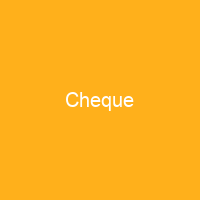A cheque is a document that orders a bank to pay a specific amount of money from a person’s account to the person in whose name the cheque has been issued. Cheque usage has fallen, being partly replaced by electronic payment systems. In an increasing number of countries cheques have either become a marginal payment system or have been completely phased out. In American English, the usual spelling for both is check.
About Cheque in brief

The use of paper money evolved from promissory notes, another form of negotiable instrument similar to cheques. The spellings check, checque, and cheque were used interchangeably from the 17th century until the20th century. However, in the Commonwealth and Ireland, the spelling cheque has become standard for the financial instrument, while check is used only for other meanings, thus distinguishing the two definitions in writing. The cheque had its origins in the ancient banking system, in which bankers would issue orders at the request of their customers, to pay money to identified payees. In some countries, such as the US, the payee may endorse the cheques, allowing them to specify a third party to whom it should be paid. There is early evidence of using cheques in ancient times. The ancient Romans are believed to have used an early form of cheque known as praescription in the 1st century BCE. These letters were used by traders in Persian territory in the 3rd century CE to issue credit letters. The letters were termed čakk, meaning ‘contract’ or ‘contractor’ These letters became later used in the Abbasid Caliphate and other Arab-ruled lands in the 4th century and 5th century CE. They were originally a legal device to allow international trade to spread. The word ‘cheque’ means ‘control’ in English through French, Latin, Arabic and ultimately from the Persian word shah.
You want to know more about Cheque?
This page is based on the article Cheque published in Wikipedia (as of Jan. 30, 2021) and was automatically summarized using artificial intelligence.







